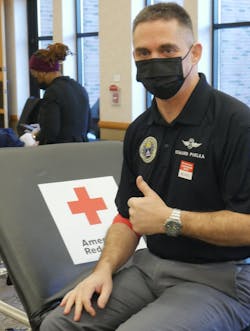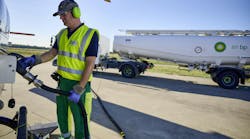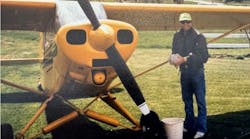Barb Clevenger of Mesa, Arizona, donated the 10,000th unit of blood collected during Civil Air Patrol’s Operation Pulse Lift mission, with the milestone occurring at an emergency blood center at CAP’s Falcon Composite Squadron 305.
“My mom gave blood, and that was something that was very important to her. I just started giving, and I’m so excited to be doing this in honor of my mother,” Clevenger said.
“Since the evening of March 17, 2020, when the surgeon general noted the critical need for blood donations during the early days of the coronavirus pandemic, and the closure of nearly 7,000 blood donation centers, Civil Air Patrol has been engaged in the coordination, planning, and execution of the longest series of blood donation center operations in the nation by a single organization,” said Lt. Col. Bob Ditch, CAP incident commander for Operation Pulse Lift.
American Red Cross CEO Gail McGovern called CAP, the official civilian auxiliary of the U.S. Air Force, “an incredible partner in responding not only to the urgent need for critical blood products” but also the need for facilities to host blood drives.
Operation Pulse Lift, launched in Arizona before the pandemic to include multiple locations in Alabama, Colorado, Kentucky, New Mexico, New York, Oklahoma, Texas and Virginia. CAP has sponsored 146 emergency blood donation centers since April 2020 to support the COVID-19 humanitarian assistance mission.
Transporting blood by land and air also is part of the CAP mission, with more than 500 trips to remote hospital locations by CAP aircrews and drivers.
The mission has also supported blood collection activities at six U.S. Army and U.S. Air Force installations through the Armed Services Blood Program. This included blood going to hospitals in Washington, D.C., and Germany that treated casualties from the August 2021 Kabul Airport suicide bombing in Afghanistan.
The Red Cross leveraged Operation Pulse Lift to support hospitals in California and Oregon during wildfire season, Texas and Louisiana for hurricanes, and the Southwest for a major winter storm. The mission’s emergency blood donation effort surged to collect 222 units of blood in response to the December 2021 tornados in Kentucky, Tennessee, and surrounding areas.
Across the country, Civil Air Patrol members and their families who don’t live near a CAP-sponsored donation center have reported their local blood donations for inclusion in the mission’s total. So far, about 5,700 units have been collected at CAP donation centers and about 4,300 at other locations, which the Red Cross equates to about 30,000 lives saved.
A recent donor was Maj. Gen. Edward D. Phelka, CAP national commander and CEO, who gave blood at a Red Cross site near his home in Michigan, setting an example to encourage other CAP members to roll up their sleeves.
In late January, the American Red Cross presented Ditch with an award fashioned from an Airbus A340 fan blade. The inscription thanked Ditch for his “lifesaving leadership during the global pandemic.”
In response, Ditch recalled his Red Cross legacy and told the story of his maternal grandmother, a Red Cross and commissioned Army nurse who served in Europe during World War I.
Operation Pulse Lift continues, with six blood donation centers scheduled through April. “The current need for blood donations is critical as the Red Cross has only a one-day supply of blood on its shelves,” Ditch said.
Acting as a Total Force partner and the Air Force auxiliary, Civil Air Patrol helps First Air Force rapidly respond to non-military threats domestically in a Defense Support of Civil Authorities capacity to save lives, relieve suffering, prevent property damage and provide humanitarian assistance.
About Civil Air Patrol
Established in 1941, Civil Air Patrol is the official auxiliary of the U.S. Air Force and as such is a member of its Total Force. In its auxiliary role, CAP operates a fleet of 555 single-engine aircraft and 2,250 small Unmanned Aircraft Systems (sUAS) and performs about 90% of all search and rescue operations within the contiguous United States as tasked by the Air Force Rescue Coordination Center. Often using innovative cellphone forensics and radar analysis software, CAP was credited by the AFRCC with saving 108 lives last year. CAP’s 56,000 members also perform homeland security, disaster relief and drug interdiction missions at the request of federal, state and local agencies. As a nonprofit organization, CAP plays a leading role in aerospace education using national academic standards-based STEM (science, technology, engineering and math) education. Members also serve as mentors to over 23,000 young people participating in CAP’s Cadet Programs.



